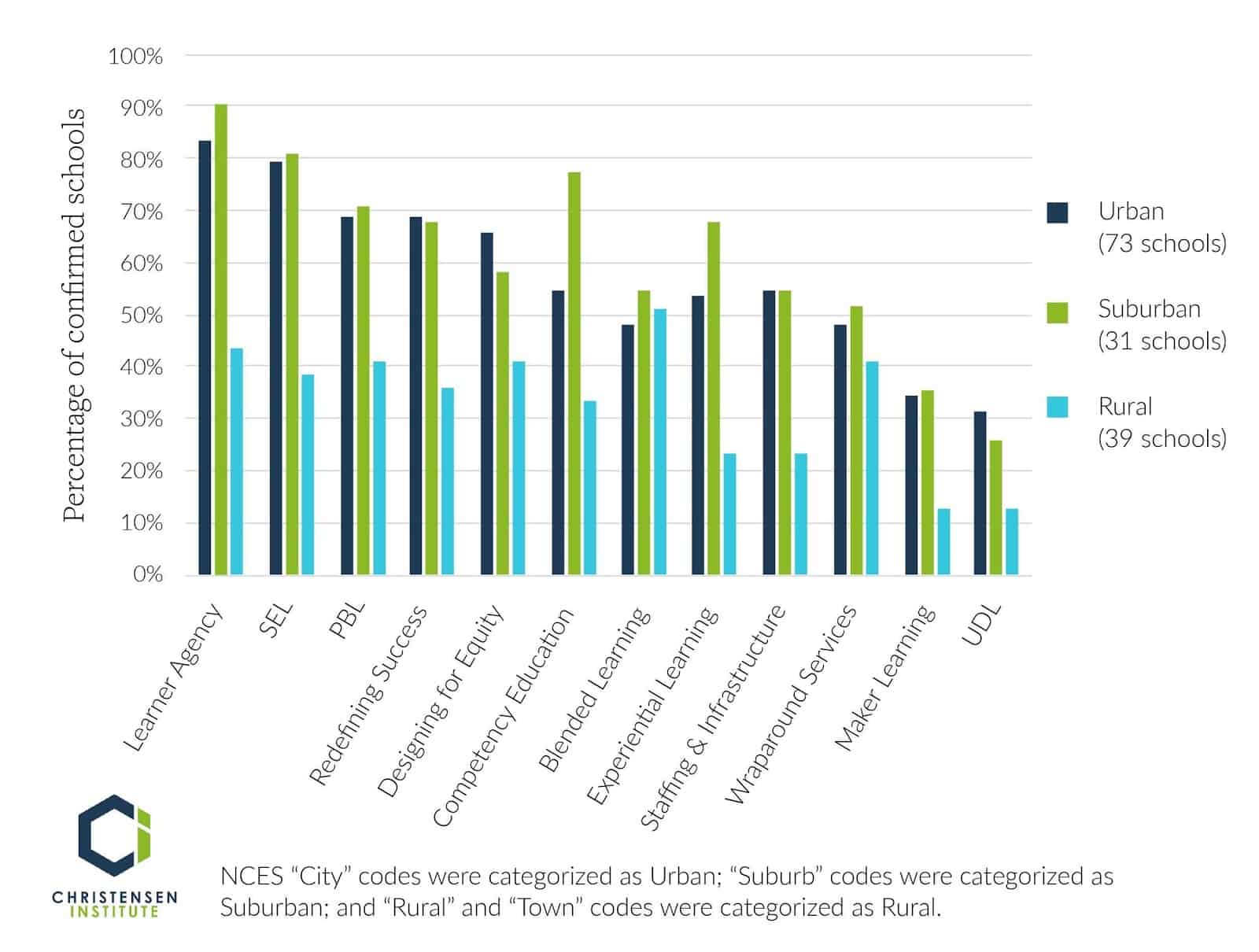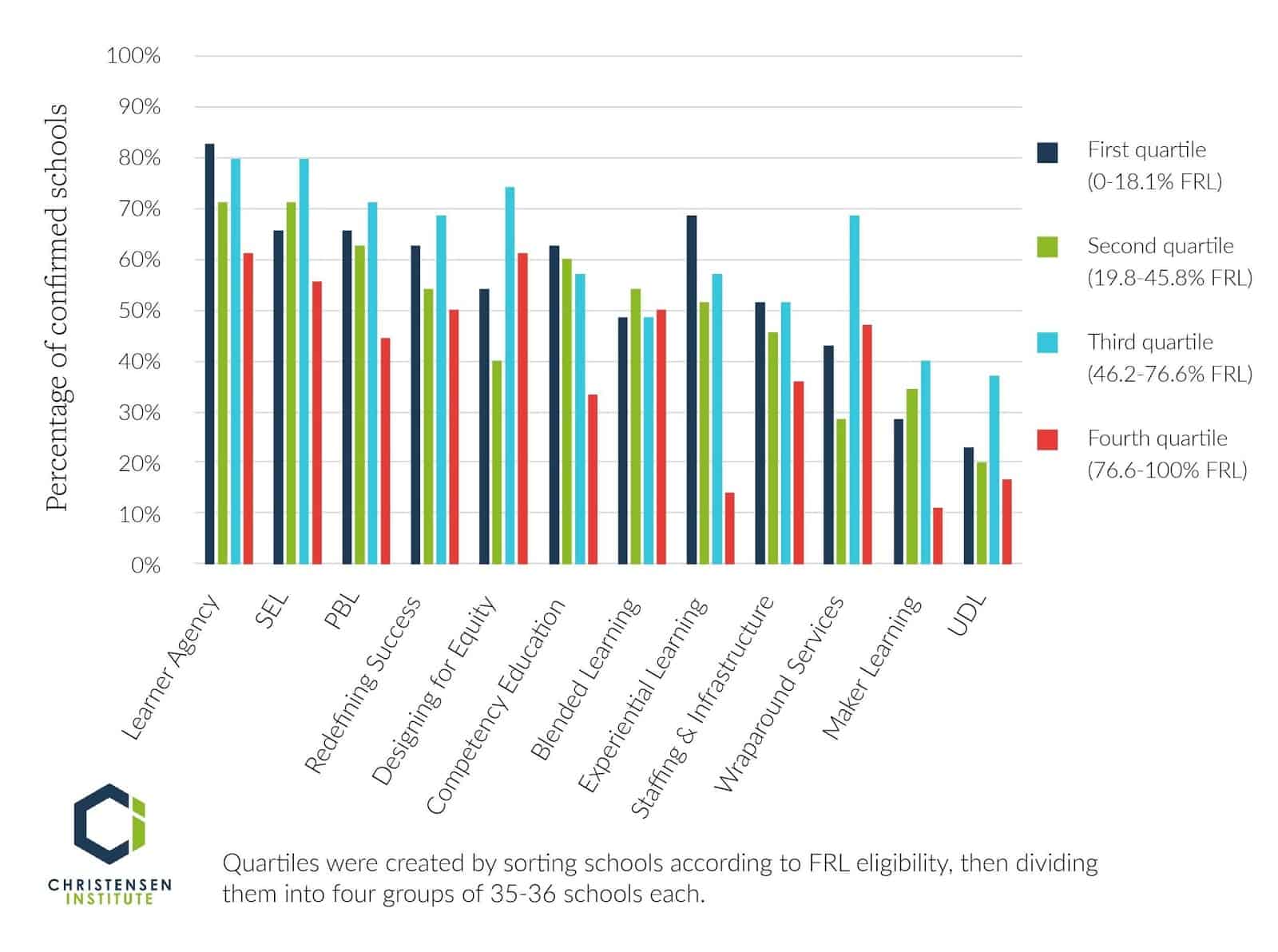3 School Innovation Insights that Challenge Common Assumptions

By: Chelsea Waite.
Assumptions about how innovation evolves and spreads can run rampant in the education space. Sometimes these assumptions are perpetuated by durable stereotypes about capacities and challenges in different kinds of schools: urban, low-income, affluent, predominantly minority, etc. Other times, assumptions can arise when a mental model for a particular approach gains popularity and then calcifies despite how actual implementation can vary. (Just think of how “personalized learning” can bring to mind “playlists,” or “blended learning” can conjure “kids in headphones,” despite a wide variety of blended and personalized learning designs.)
One factor contributing to these stereotypes and fixed mental models is that we lack divers, comprehensive, and broadly accessible information on how schools are reimagining the learning experience for students. In its absence, many researchers, funders, and thought leaders rely on word-of-mouth strategies for surfacing innovation, which can inadvertently contribute to an echo-chamber effect that makes it hard to source examples beyond a narrow set of well-studied, well-known exemplar schools that are highlighted time and again.
In an effort to break out of the school innovation echo chamber and surface a more diverse set of schools, the Christensen Institute recently launched the Canopy project, a collaborative initiative that reimagines how school innovation data is sourced and structured. We generated Canopy data from a two-step nomination process that shares information about school design from a diverse set of schools not commonly referenced on typical school lists. The project uses a set of 88 “tags,” or keywords and phrases representing aspects of school design, that nominators and school leaders applied to each school’s nomination to describe elements of the school’s design.
Canopy data on school models, sourced from 173 schools that verified their information, reveals insights that may otherwise have gone unnoticed by the field. Whether you’re deeply familiar with school innovation or just starting to learn more, here are a few takeaways from the newly-released Canopy report that may challenge your assumptions.
1. Assumption: In public districts, suburban schools are the ripest ground for innovation.
There’s a common perception that innovation can be an easier task in suburban school districts, which are often smaller (and, so the thinking goes, more nimble) than urban districts, and more well-resourced than rural ones. On the one hand, Canopy data suggests that rural schools may indeed face barriers to innovation since they are less often cited for pursuing almost all of the 12 general approaches to student-centered learning that we tracked.

Surprisingly, however, urban and suburban schools were often tagged at similar rates for the 12 general approach categories, with two exceptions: competency-based education and experiential learning. While it’s worth investigating why those approaches may be taking off more often in suburban contexts, Canopy data suggests that the blanket assumption that suburban school innovation outpaces rural and urban schools may be off the mark.
2. Assumption: Project-based learning (PBL) is attainable mainly in affluent suburban schools.
In short, it’s not—but the picture of where and how PBL is taking off is complex. In keeping with the trend noted above, urban schools were tagged for project-based learning at equal rates to suburban schools, challenging the assumption that urban schools have less flexibility or resources to do PBL compared to suburban ones. However, rural schools were dramatically less often tagged for PBL, raising questions about the particular barriers that rural schools face in implementing project-based approaches. Regarding socioeconomics, PBL was cited frequently, and at almost equal rates, among schools with up to 76.6% free and reduced-price lunch (FRL) eligibility. That suggests that it’s inaccurate to say that PBL is only for the most affluent schools. However, the highest-poverty schools appeared to be pursuing PBL at lower rates, suggesting that these schools may either choose not to implement PBL or struggle to do so.

Here’s where things get more complicated: the PBL tag had a relatively high correlation with experiential learning, indicating that project-based and experiential learning models might be closely related (either in their definitions or in implementation—meaning some schools may be pursuing them in tandem). However, these models may also be reaching different populations of students. When it came to experiential learning, the data shows suburban and more affluent schools being tagged much more often compared to urban, rural, and less affluent schools. It’s possible that while project-based approaches may be more widely adopted among schools with a variety of demographics, experiential and real-world components of project-based models may be more common in affluent and suburban contexts.
3. Assumption: “Moving beyond test scores” means prioritizing social-emotional learning (SEL).
The conversation about redefining student success is gaining traction, especially in terms of moving beyond metrics like test scores and graduation rates. But what are metrics moving towards? In many circles, the targets for an expanded set of success metrics increasingly include social-emotional learning, such as self-efficacy and resilience (browse this gallery of district “Portraits of a Graduate” to see some examples).
Canopy data suggests that there may be more to it—and what characterizes redefined success may vary by context. When we investigated relationships between tags, we found that learner agency, SEL, and redefining success all correlated with each other relatively strongly. This cluster of relationships supports the idea that redefining success is related to social-emotional learning as well as greater ability for self-direction and self-management. However, our analysis shows that while designing for equity (defined as putting the needs of historically marginalized students at the center) was also correlated with redefining success, it had a slightly weaker relationship to SEL and a much weaker relationship to learner agency.
What might this mean? Correlation scores are just numbers, so we can’t claim that the clusters of practices are playing out meaningfully in schools without further investigation. But it raises the possibility that schools focused on designing for equity may envision a different set of priorities and metrics around student success—a vision less driven by a philosophy of agency or social-emotional development. Given that the designing for equity tag tended to appear more frequently in higher-poverty schools and those with higher Black populations, the answer could have implications for which students are being exposed to what sorts of redefined outcomes.
It’s time to bring our assumptions about school innovation to task. More comprehensive, diverse data on how schools are reimagining the student experience is our bet for how to challenge stereotypes, confirm suspicions, and raise new questions. Check out the Canopy project report and dataset to learn more about our findings from schools around the country.
For more, see:
- 5 Ideas for Learning About Digital Citizenship
- Podcast: Katherine Prince on Navigating the Future of Learning
- Playing with Purpose: Using Games to Enrich Learning & Engage Students
Stay in-the-know with innovations in learning by signing up for the weekly Smart Update.
Chelsea Waite is a research fellow at the Christensen Institute where she analyzes how innovation theory can inform the design of new instructional models. You can find Chelsea on Twitter at @chelseawaite.






0 Comments
Leave a Comment
Your email address will not be published. All fields are required.